What is going on in the kitchen at Heron & Grey, the Michelin-starred restaurant in the market at Blackrock, Co Dublin?
Mushroom “glass” is being conjured up from dried powdered chanterelles, the deeply savoury mother-of-pearl tinged wafers dissolving on the tongue. Oyster juice is destined to be turned, as if by magic, into edible “aluminium foil” and a chef with a blowtorch is slicing plastic drinking straws in half and then resealing them.
There is a photography studio set up in a corner, and the dining tables have been dragged together to form a central desk, on which piles of study notes and report sheets jostle for space with computers and coffee cups. A dehydrator is whirring quietly away as a first step in the process of turning koji (fermented rice grains) into miso.
This is what a development kitchen looks like. It's not a new concept. Many of the restaurants at the starrier end of the Michelin spectrum have them – dedicated spaces where chefs are freed from the demands of actually feeding diners, and instead devote their time and creativity to dreaming up the next new things.
Ferran Adrià used to close his three-star El Bulli for six months of the year and decamp to Barcelona to work in a small space dedicated to developing an entirely new menu for the next season.
René Redzepi's Noma in Copenhagen has a fermentation and research lab (eight walk-in temperature and humidity controlled rooms), as well as a development kitchen.
But at Heron & Grey, where the kitchen and dining room occupy a space that’s smaller than the Noma staff locker-room, the restaurant has to close its doors to customers for three weeks to allow for this concentrated period of research and development.
The staff, or the team, as the restaurant's co-owners Damien Grey and Andrew Heron would call them – Jozef Radacovsky, Róisín Gillen and Ailish O'Neill – are on board for the experiment, and are having their salaries covered. But there is a key member of the team missing in action.
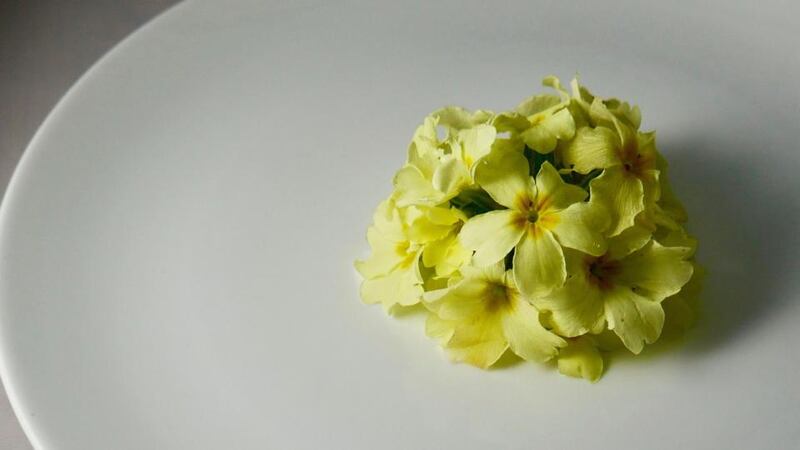

General manager Heron and his wife Jessica were due to welcome their first child in early April (baby Mabel, 4.3kg, arrived on April 10th), and it was this life event that triggered the decision to close for three weeks and embark on the R&D project, despite the drain on the restaurant’s finances.
“It’s a big investment, it’s very risky,” Grey says. The three-week closure will cost the company €25,000. “I look at the top-end guys and they’ve got test kitchens, they’ve got dedicated teams to do all this. They have an army behind them and the space to do it.”
There are only 66 seats a week available at this restaurant, which serves dinner Thursdayto Saturday, and they are booked up within minutes of tables going on sale. So it must have been tempting to hire in help to cover Heron’s paternity leave.
But this pair don’t think like money-men; they think like perfectionists, and they reckoned there was a better option. “I wanted to go back to basics with the team. We’ve been on this path, and I don’t think we’ve really stopped and reflected on what we were doing,” Grey says.
The “bible”, a giant folder stuffed with every menu they’ve served since they took over the space in December 2015, bears testimony to the hard work that goes on in this tiny space: there are recipes for 632 dishes in there, and no dish was ever repeated for more than its two-week run.
“Dishes we are not struggling with, it’s new techniques, new applications we are after,” Grey says, explaining that one of the aims is to allow them to work out ways to elevate existing dishes.
“I’ve grown up in the era of El Bulli and Alinea, I’ve grown up with Heston [Blumenthal], them approaching food with a scientific mind just got me buzzing,” he says.
A schedule of activities is drawn up by Grey for the three-week project. “It has been really daunting, I’ve had to write, like, lesson plans, for each day. It had to be structured and it had to make sense of what we’re doing.”
In early spring, The Irish Times receives an invitation to be part of the project, with an open door to participate, photograph and film the process.
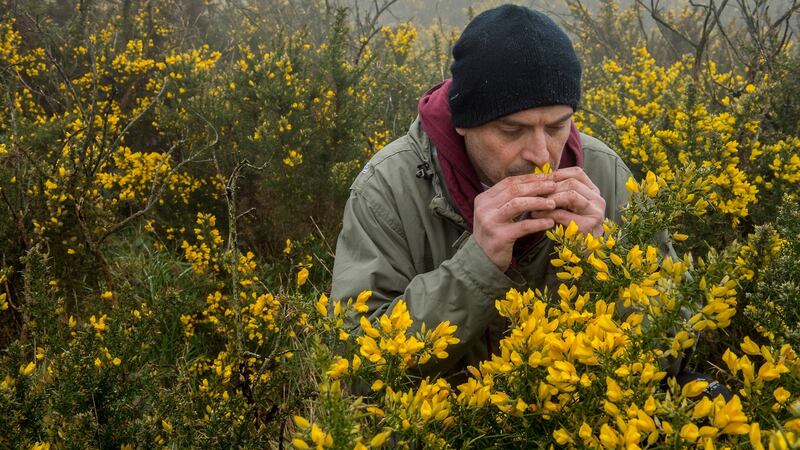
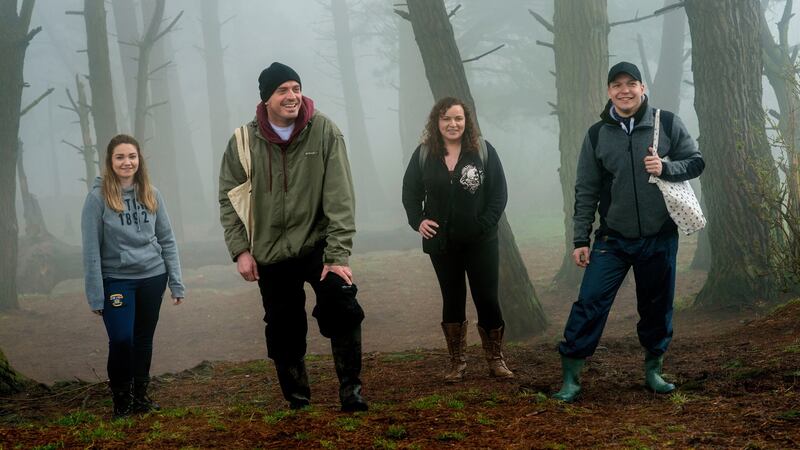
Tuesday, March 27th: Waste nothing dinners
There’s a giddy, party-that-the-parents-don’t-know-about feeling as diners file through the H&G doors on a Tuesday night, when normally it is closed. For the next three nights, the restaurant will be serving a cut-price €38 menu of a minimum of five courses, made entirely with the contents of its freezer and larder.
“The rule for us is we can’t buy anything,” Grey tells his first group of diners, a mix of regulars and friends invited by text to book a seat and join in the experiment.
“We’re doing something we’ve never done before, we are clearing out back stock and cooking on the fly. We’re going to be really exposed. We are addressing the food waste issue, which is huge in our industry.”
Grey’s freezer isn’t like yours and mine. The opening evening’s 11-course menu utilises pigeon legs left over from a dish that used only the breasts; neck and shoulder of lamb from a whole animal breakdown, and trimmings of suckling pig, cooked in kelp. It also features mackerel, chicken, snails and blood oranges, and because of the small quantities of ingredients available, entirely new menus have to be created for the next two nights.
“I just made it,” Grey says when asked if he had enough food for the final night customers. “When I looked in the freezer at the end of the week, it was empty, and nothing went in the bin. Also, we got three new dishes that we’re going to come back to and fine tune and refine.”
Plans are made to repeat the exercise periodically to tackle food waste head-on, and also to make the restaurant accessible to more people.

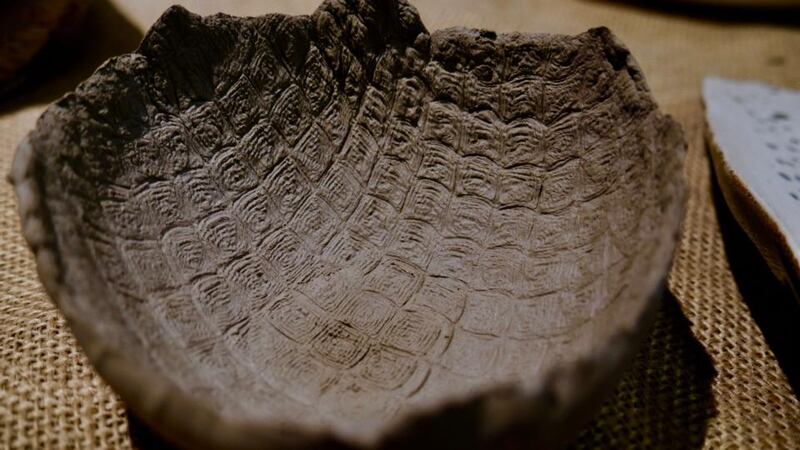
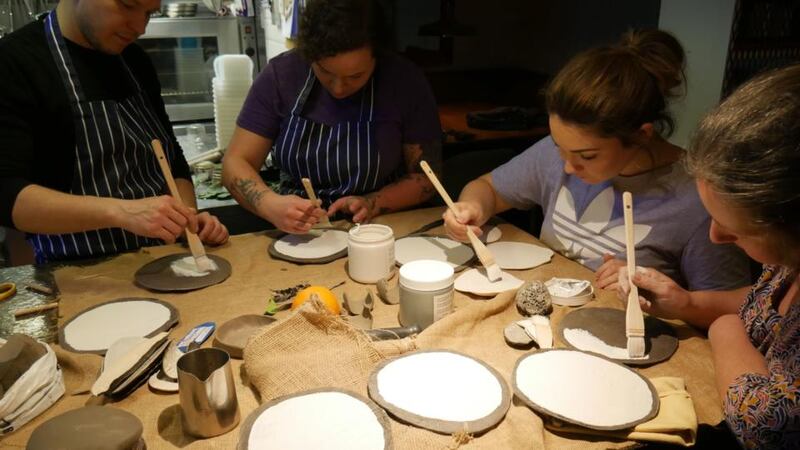
Wednesday, April 4th: Hands-on pottery class
After a full day spent brainstorming umami – "what is it, how do we use it, are we using it properly?"; working on the perfect equation to achieve balance in a tasting menu, and finalising a preserving plan for spring and summer – the team regroup to work with potter Leona Dixon.
Dixon, a secondary-school art teacher, met the H&G team when she was looking for an outlet for a glut of veg from her allotment and turned up on the doorstep “with my string bag of artichokes”.
Now, through their allotment partnership, Dixon is a vital link in the restaurant’s supply chain, as well as being responsible for designing and making many of the distinctive plates and bowls they use.
But today, it is the chefs, Grey, Radakovsky and Gillen, and Ailish O’Neill who works front of house with Andrew Heron, who must put their artistic talents to the test. Radakovsky is busy making pottery bowls with a ladle and a waffle fabric cloth. Gillen is pressing Japanese-inspired leaf patterns into delicate plates, and O’Neill is indenting clay with a rough texture, using the cut surface of a log.
Grey’s experiment with woven strings of clay is less successful. Making waffles, he calls it. “Do you mind if it doesn’t work,” Dixon says as she flattens the prototype snack plate, sending its creator back to the drawing board.
“It’s important to get them right, and have them suitable for purpose, while still being beautiful,” says Dixon, who has made around 350 pieces for the restaurant, learning along with way what works and what does not. “Edges can be uneven but not spikey”, and “they need to be able to hit the dishwasher, they need to take abuse”, Grey says.
By the end of the day, the team have hand-made three complete new sets of bowls, butter plates and cheese plates that will be fired and glazed for use in the restaurant.
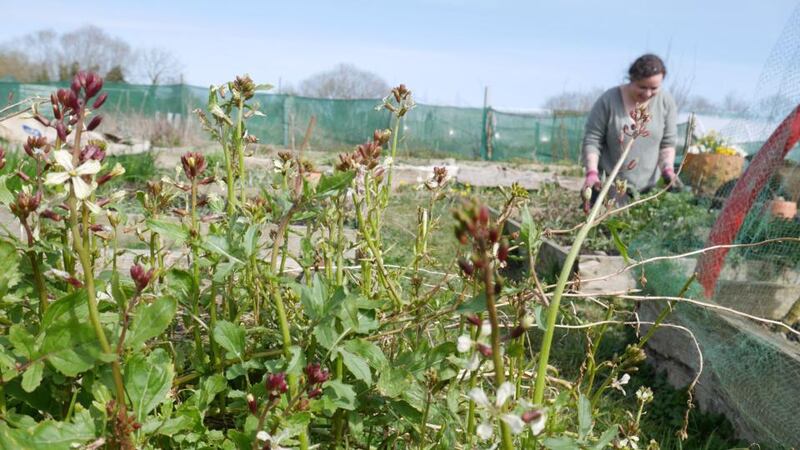
Thursday, April 5th: The big allotment plan
Working initially with Dixon on her family allotment in Ratoath, H&G have expanded their involvement in growing their own produce, and are now finalising arrangements to move their production to a farm in Co Meath.
“We’ve built the maps, we’ve got a planting schedule in place and a seed bank. Last year we grew 25 per cent of the veg for here. It doesn’t save us any money, but I know what’s going on, I know what the soil is like, I know what the air quality is like out there,” Grey says.
And does it taste better? “Yes, I think it does. I can get things out of the ground and they’re here within an hour. We’re going to set up a little kitchen out there and do all our fermenting there, so the second it comes out of the ground, it’s washed, and then it’s fermented and packed away.”
Today they are finalising their planting plan and talking about last year’s growing, and how they could do it better. “What I learned last year was that I don’t need to plan as much, I need to plant a wider variety,” Dixon says.
“He [Grey] uses the entire plant. For example last year we had a bumper crop of purple kale. Normally when they go to seed, we pull them up and they go on the compost heap.
“But he was all over the flowers because he wanted to pickle them and he wanted the buds for steaming and doing all sorts of things with. Suddenly the plant started to give a second and a third crop. He saw it in a different way.”
Tuesday and Wednesday, April 10th-11th: Recipe testing, techniques and experiments
“Enjoy that, I’m envious,” says a colleague as I head off to spend some time “recipe testing” in the H&G kitchen.
Later, debating the possible uses of unflavoured agar agar – a jelly-like substance, obtained from algae – at three different points of set, from slightly slithery and wobbly to grainy concrete, and trying hard to pretend that the frozen water from those repurposed drinking straws is actually cucumber and oyster dressing, reality has set in: there will be no cook’s treats and delicious morsels today.
Actually there is one. The mushroom “glass” is delicious, the sparkly shards dissolving on the tongue, leaving behind an intense umami hit. Success.
“Mark from Ballyhoura Mountain Mushrooms sent us up a big batch of things they’re working on. One of them was salted winter chanterelle powder, so we made a stock out of that, and used Ultra-Tex [a thickening agent], and dehydrated it.”
The resulting edible “glass” is a technique they will be applying to other ingredients too, with the aim of developing a dish made entirely of things that have been pureed, dehydrated and magically transformed.
“I want to do a dish that’s a snack at the very beginning, where you basically get like a filing cabinet full of files, or sheets of edible glass, and you eat them and it’s sweet, sour, bitter, savoury,” Grey explains.
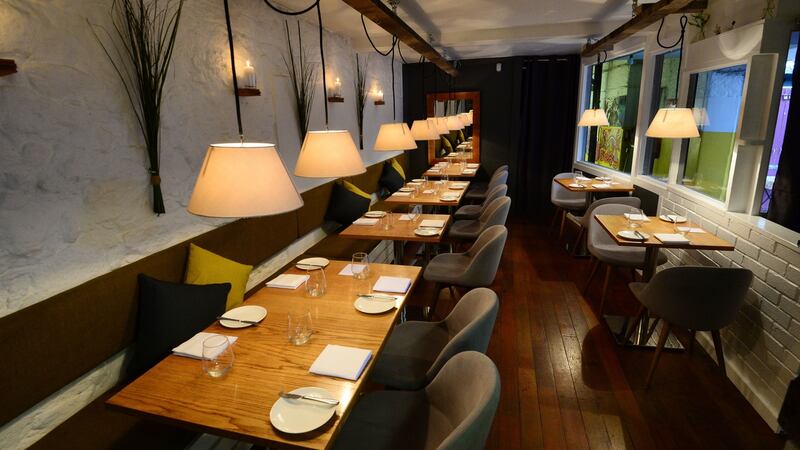
Other experiments are less successful. An attempt to make the oyster aluminium foil, using oyster juice, agar agar, salt and silver powder – a technique created by Danish chef Ronny Emborg, author of The Wizard's Cookbook – goes back to the drawing board. There's a suggestion that the instructions in the book could be more comprehensive. "A lot of these high-end books are really really vague," Grey says. Deliberately? "Absolutely."
The plan to make big sheets of the foil to use as a veil concealing a “micro seabed” made with “loads of sea vegetables, maybe a little crab”, needs more work, it seems. Consolation is dished out in the form of a more successful experiment – sugar lollipops made with wild primrose flowers and rosewater.
The kitchen is also happy with several discoveries, including a new technique for making “the perfect herb oil”, a quick-ferment lemonade, ready to drink in three days, that will be added to the non-alcoholic drinks pairings, and those cucumber and oyster frozen rods. These will stick up out of a salad course and melt into a puddle of dressing on the plate, it they’re not picked up and crunched on first.
The agar agar experiment yields a lightbulb moment. Grey picks up a black marker and begins sketching a new dish on the wall tiles. It’s hard to follow his lightening quick creative process, but it appears that a transparent bowl will contain layers, from the bottom, of fermented mushroom puree, pickled mushroom, raw mushroom, and mushroom consommé, lightly set, topped with wild vetch and nuts or seeds.
The magic part will be seeing the set consommé dissolve when the bowl is brought to table in a water bath of some sort. But don’t expect to see this on a menu anytime soon. Grey spends considerable time perfecting a dish before it makes the menu.
A “mushroom risotto” that he is also working on, for example, will be made entirely of pureed and dehydrated ingredients. “That dish is two, maybe three years away from actually being on a plate,” Grey says. He will need a centrifuge and distilling equipment to execute it. “It’s just a concept, but that’s the future, that’s where we want to go.”
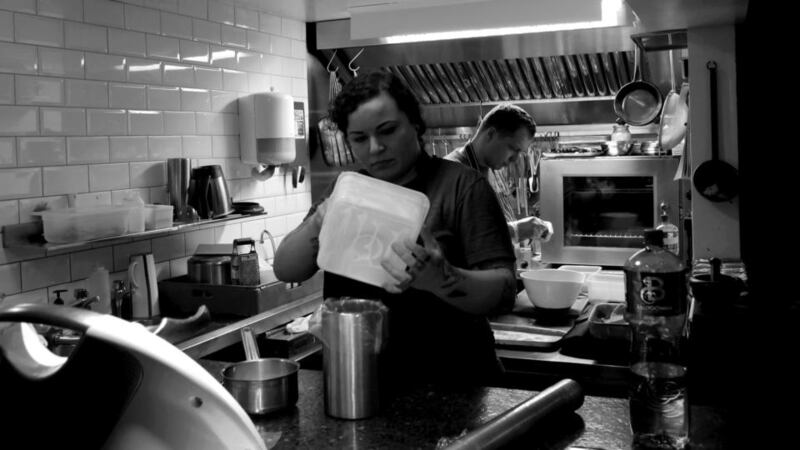
Friday, April 13th
Conclusions: what we got out of this . . .
Damien Grey: "It's been one of the best things I've ever experienced as a chef. I feel we're very close now as a team and that's going to show. We have an idea of where we want to be in a couple of years' time. And we have a whole bag of new tricks to play with. Look at this [holds up a squid ink tuile] they're all over Instagram, but I'd never done one before and so we played with it and we got it right."
Jozef Radakovsky: "There were things I thought I knew, but when we sat down to really explore it, I realised I didn't really know. It was an eye-opening two weeks. I learned a lot and we bonded more strongly together.
Róisín Gillen: "It's been a huge learning experience, the amount we've done in such a short space of time. Even the simple things. Like all I was doing today was working on getting the correct percentages for different thickening agents, but it will make such a difference when it comes to making purees."
Ailish O'Neill: "I don't come from the same culinary background as the guys, so it was interesting seeing the way they worked, the mistakes they made, and having no pressure, they all helped each other out. It was a massive team-building experience."
DAMIEN GREY ON TAKING HERON & GREY TO THE NEXT LEVEL
Hidden away behind a pile of storage boxes, there's a €20 note Sellotaped to a wall in the Heron & Grey kitchen. "That's the first money we took in," Grey says, reminiscing about the day in December 2015 when he and Andrew Heron took over the space from James Sheridan and Soizic Humbert who had been running it as Canteen at the Market.
I was a customer at Canteen the night Grey worked a shift with Sheridan, to see how the kitchen functioned. “I’ll never forget that night, I was physically ill, I was so absolutely petrified buying it,” he reminisces.
It’s easy to think that his anxiety was unfounded, in the light of Michelin-star success, and a reservations book that fills up quicker than computer connections can handle .
A recent move to monthly reservations means diners have more opportunities to secure one of the 66 seats a week that are available. May 1st, 10am, was the most recent release date, for reservations for June 2018. Even so, it can be tough to nail a spot.
“We don’t get to have our mates in, or our families. My wife [Claudine] has been here once, Andy’s wife twice, since we opened, just because of the madness of it all. Don’t get me wrong, we’ll never complain about that and I’m never going to gloat about it either.”
But despite its popularity and critical acclaim, the two partners are certainly not getting rich from the venture. “We take hardly anything out of this business, we take what we need to be able to pay our bills, and that is it. To put it in context, I get less than I was earning in Chapter One.”
Profits are ploughed into improvements and development plans such as the allotment, and financing the R&D project. There is also a savings fund earmarked for a move to a bigger premises – eventually.
“We’re outgrowing this space fast, that’s the problem. It has never stopped us doing something that we wanted to produce, but . . .” Grey wavers, sounding a little despondent for the first time in this three-week open-door access.
“We’ve been talking about a move for about a year now. But I’m not paying anybody €330,000 a year for rent and rates.” They currently pay €24,00 a year.
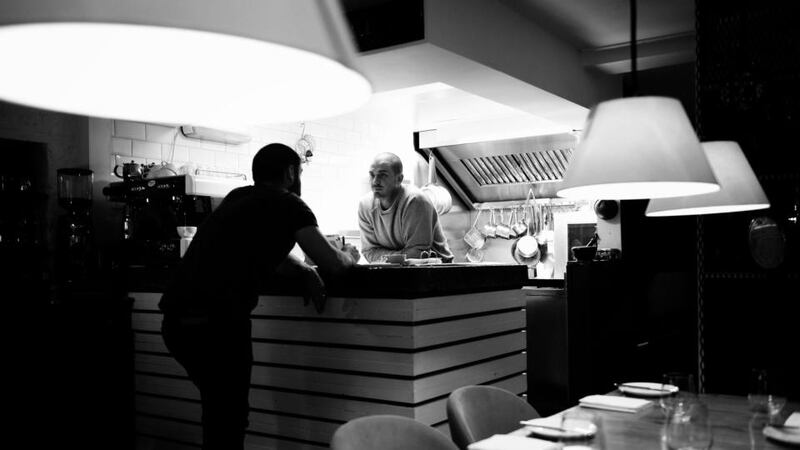
But the duo are not not wasting too much time wishing for bigger and better premises – those ambitions are firmly directed at elevating the level of the food they deliver and boundaries they intend to cross.
There are big moves afoot, within the tiny space. “Up until now I’ve been changing the menu every two weeks, it’s seasonal as hell, but we’ve been committing to a dish for two weeks.”
The fortnightly menus, each entirely created from scratch, are on the way out. “I want to eliminate that now and commit to seasonal ingredients, so it [the menu] will be constantly evolving.”
There are plans too, to turn that big ring binder that stores every recipe they’ve created, along with the knowledge they’ve gleaned along the way, into an app. “It will be everything we’ve learned in one piece of kit; a manual of seasonality, our allotment experience, recipes, techniques, costings, forecasting, tips on what to expect, basically a complete manual on how to run a small 25-seater restaurant.” They hope to have it completed by 2020, and are interested in collaborating on it with a university or research institute.
Regular research and development stints, such as the one they’ve just completed, will also be part of Heron & Grey’s ongoing narrative. “We’ll get to a point where we understand what we’re doing completely, then from there we’ll work with what we know best. But I don’t see us slowing down.
“I was always told that a restaurant has to have a story or a theme. We have a story and it’s a great one and we’re going to stick with it. It’s in tune with everything that’s going on, it’s sustainable, we’re working with local people, we’re not just coming in serving food and going home, we’re creating from the pots to the food.”
















